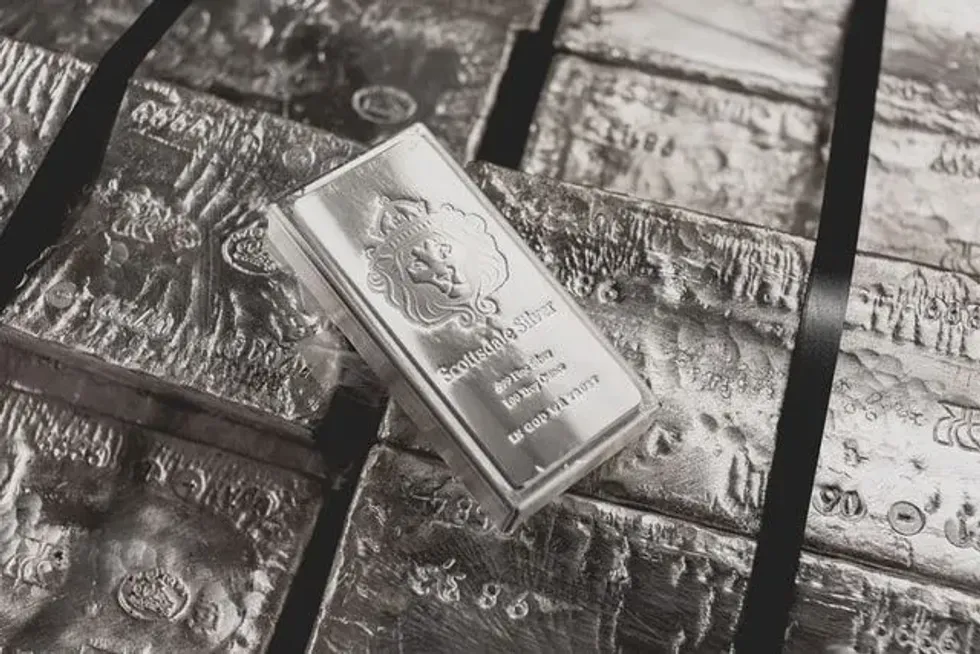Silver is an element (metal) with the atomic symbol Ag and atomic number 47.
The symbol 'Ag' comes from the Latin word 'Argentum', which means 'silver'. The word 'silver' originated from the Anglo-Saxon word ‘seolfor’. It is a soft metal containing a white luster, which requires a very high degree of polish.
Natural silver has two isotopes. According to the Jefferson National Linear Accelerator Laboratory, pure silver is the finest electric conductor and heat among all metals.
Silver is also the best reflective element of light waves, which is why it's widely used to manufacture mirrors. However, when exposed to air, silver tarnishes and turns dark gray, necessitating periodic polishing. Polished silver can reflect more than 95% of visible light.
Because pure silver is too delicate for tableware and jewelry, a family's most valuable knives, forks, and other silverware are almost certainly sterling silver, 92.5 % silver, and 7.5% copper alloy. Some gadgets and batteries contain silver.
Nanoparticles of silver, which have antibacterial qualities, can be interwoven into garments to prevent an infection from forming due to perspiration and oil deposits, according to the Royal Society of Chemistry (RSC).
The silver-bearing fraction of these ores is usually recovered as a by-product of lead and copper production since the majority of silver-bearing ores also include the essential metals copper, lead, or zinc, or a combination of the three. Fire or electro-refining and smelting are then used to recover pure silver from the crude portion.
Silver alloys with copper are used for jewelry and coinage because they are tougher, harder, and more fusible than pure silver. The amount of silver in these alloys is expressed in fineness, which is defined as parts of silver per thousand parts of alloy.
Sterling silver has a purity of 925, which means it includes 92.5% silver and 7.5% of another metal, usually copper.
An alloy comprising 20% copper and 80% silver is known as jewelry silver (800 fine). The yellow gold used in jewelry is made up of 25% silver, 53% gold, and 22% copper.
Characteristics Of Silver
Silver is by far the most reflective metal, reflecting 95% of all visible light. Unless you're using UV light, in which case it'll reflect like a stone.
Pure silver nuggets can be discovered in lead, copper, and zinc ores, as well as horn gold, silver, argentite, and copper-nickel alloys.
Silver is stable in water and oxygen, but it tarnishes when gets exposed to ozone, hydrogen sulfide, or sulfur-containing air as a result of a reaction with sulfur compounds, resulting in a black sulfide layer.
Silver, along with gold, is the most malleable metal. One ounce of silver can be turned into an 8,000-foot-long (2,438.4 m) cable.
During the processing of silver, a powerful explosive known as silver fulminate can occur.
Silver has a cubic crystal structure.
Humans cannot be poisoned by silver! In reality, it destroys some bacteria; nevertheless, this does not mean you should eat any.
Reduced silver can be stored in numerous human tissues and silver compounds can be carried into the circulatory system.
Argyria is a skin ailment caused by the absorption of silver into bodily tissue, and it is distinguished by gray skin pigmentation and mucus.
Unlike antibiotics, bacteria cannot build resistance to silver.
During World War I, silver compounds were utilized to prevent illness from spreading in war zones.
Silver is occasionally used to cure a common cold, sinus and flu viruses, and lung infections, in alternative medicine.
Because of its antibacterial properties, the use of silver has recently been emphasized in papers used by medical experts.
Dentists utilized silver for cavity fillings in the past.
Throughout history, silver has been referred to as 'poor man's gold.'
‘Sterling' relates to the Normans' silver coins, which were adorned with stars; their term 'sterre' transitioned to 'starling', which then became 'sterling'.
Sterling silver is the most prevalent type of silver. The remaining 7.5% is made up of various metals, including copper, and is 92.5% pure silver.
Alpaca silver is an alloy of metals with characteristics akin to stainless steel, rather than genuine silver.
Various metals are mixed with silver to make it more durable and survive longer in jewelry.
Fine silver is commercially available and is at least 99.9% pure, but it is too soft for general usage.
Sterling silver has been around since the 13th century and comes from the United Kingdom.
A single grain of silver may be compressed into a sheet 150 times finer than ordinary paper.
In jet engines, silver bearings are employed to provide a higher level of safety.
Silver is more difficult to work with than gold, although it is softer than copper.
Silver has been the subject of more patents than any other metals combined.
After use, the majority of industrially utilized silver ends up in landfills, where it is permanently lost.
About 20 billion ounces (566,990,462.5 kg) of silver are used as coins, jewelry, religious and cultural objects around the world today.
Early photography was made feasible by the use of silver. According to the Royal Society of Chemistry, silver nitrate (silver coupled with nitrogen and oxygen molecules) was employed on photographic plates in the original, clumsy cameras as it reacts to light by turning black, allowing photographers to catch a single moment of light.
Silver is still used in conventional photography, despite the rise of digital cameras. In 2003, the most recent year for which data is available, 1,889 lt (1,920 t) of silver were used for photographic purposes each year.
With 1,210 lt (1,230 t) flowing into cables and gadgets in 2003, electrical and electronic usage were the second most prevalent major industrial use for silver.
With only 486 items, jewelry, sterling silver, and silver electroplated products came in third.
The lines that melt ice on a car's rear glass are made of silver.
A silver nitrate compound is used to create the celluloid film receptive to light when taking a photograph. This accounts for almost a third of all industrial silver usage in the United States.
In the past, silver was used to back mirrors because it was very reflecting. Nowadays, aluminum is used since it is less expensive and does not tarnish over time.
Scientific Uses Of Silver
Electrum is a natural alloy of silver and gold that occurs naturally.
Silver is the best conductor of electricity of all the elements, and all others are compared to it. This is the only element that has a conductivity of 100%, with copper coming in second at 97%.
Silver has the lowest contact resistance of any metal and is also the best thermal conductor.
Silver has an atomic number of 47 and an atomic weight of 107.8682.
Silver has a melting point of 1,763°F (961.78°C) and a boiling point of 3,923°F (2,162°C).
Silver, with the E number E174, is often used as a food additive or colorant.
Silver is under the classification of transition metals.
Antibacterial bacteria present in the body are destroyed by the mineral silver, which has the incredible capacity to combat and eliminate antibiotic-resistant super pathogens. Larry C. Ford, MD, discovered that silver can destroy over 650 fungi, bacteria, parasites, molds, and fungi that have the ability to sprout diseases while working at UCLA Medical School in the '80s.
Simultaneously, testing revealed that silver had no known negative effects.
Heals injuries and skin conditions: Not only can silver effectively destroy disease-causing germs, but it also can induce a stunning and unexpected regrowth of human tissues and bone at the infection site. Topical silver treatments should be investigated for burns, thrush, periodontitis, and other ailments. Other skin disorders such as psoriasis and eczema can also be helped by silver.
Viruses are prevented and killed by this product: Silver is one of the natural therapies for stopping infections, according to Martin Hum of the Institute for Optimum Nutrition. Colloidal silver is a suspension of pure silver in water that is employed in contemporary supplements. It works by inhibiting the enzymes that allow viruses, bacteria, and fungus to use oxygen.
Silver can treat and prevent sinus infections in allergy sufferers, according to research released by Forum for Allergy and Rhinology in 2015. Hidden pathogen infections have also been linked to respiratory inflammation in people with allergies and asthma, according to research. Silver kills Pseudomonas aeruginosa infections.
Treats and prevents bronchitis and pneumonia: Silver is a wonderful mineral that, when taken internally, can aid in the prevention and treatment of pneumonia and bronchitis.
Treats and prevents colds and influenza: Small doses taken daily can help to strengthen your immune system and prevent colds and flu.
Purifies water: According to recent UCLA experiments, two tablespoons of silver with a strength of over 30 ppm can filter 1 US gal (0.037 hl) of water.
Antibiotic resistance can occur when a person uses too many antibiotics over a long period of time. The microorganisms that are killed by silver do not develop resistance or immunity.
Financial Aspects Of Silver

Money is one of the most usual places to find silver.
In at least 14 recognized languages, the words 'silver' and 'money' are grammatically equivalent.
Since roughly 700 BC, silver has been used as a kind of currency.
It has been utilized in the production of coins and other types of money all over the world.
Silver has been used in circulating currency in the United States until 1970. It became too expensive to use in business-strike coins by that time. The United States Mint, on the other hand, continues to produce a range of non-circulating legal-tender silver coins, such as commemoratives and bullion coinage.
Coins issued in the United States had 90% silver until 1965. Between 1965 and 1969, it plummeted to 40%. Silver usage has exceeded production in recent years, resulting in the use of lower amounts of metal.
A bag containing $1,000 in pre-1965 coins would contain approximately 715 ounces (20,269.9 g) of silver.
Silver is now less valuable than gold, but its value fluctuates based on supply and demand.
Since roughly 700 BC, silver has been utilized as a form of currency.
The United Kingdom created 5,00,000 ounces of silver coins and medals in 2003.
In 1158, King Henry II of England issued the first silver money.
In the seventh century BC, the Lydians were among the first to employ silver as currency, and the Greeks swiftly followed suit.
In the late 15th century, silver was at its most valuable.
FAQ
What is special about silver?
It has antibacterial and antimicrobial properties. It is also utilized to coat medical devices.
What are the five common uses for silver?
Silver has been used for coins, mirrors, electronics, medical equipment, jewelry, and other decorative items for thousands of years.
What is silver made out of?
Silver is obtained from its ores called ruby silver and horn silver.
How much is silver per ounce?
$25.82.
What is the current price of silver?
The price of silver per gram is $0.83 and per kilo is $834.31.
Who discovered the silver element?
There is no particular person who has discovered silver. It was first discovered in modern-day Turkey.
What type of element is silver?
Silver is a metal that comes in block-d of the periodic table in the transition element section.










